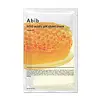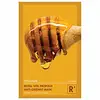What's inside
What's inside
 Key Ingredients
Key Ingredients

 Benefits
Benefits

 Concerns
Concerns

 Ingredients Side-by-side
Ingredients Side-by-side

Water
Skin ConditioningGlycerin
HumectantPolyglycerin-3
HumectantButylene Glycol
HumectantDipropylene Glycol
HumectantHoney Extract
HumectantMelia Azadirachta Flower Extract
Skin ConditioningAureobasidium Pullulans Ferment
Skin ConditioningMelia Azadirachta Leaf Extract
Skin ConditioningCurcuma Longa Root Extract
MaskingOcimum Sanctum Leaf Extract
Skin ConditioningAlthaea Rosea Flower Extract
Skin ConditioningPropolis Extract
Skin ConditioningTheobroma Cacao Seed Extract
AntioxidantRoyal Jelly Extract
Skin ConditioningCorallina Officinalis Extract
Skin ConditioningPersea Gratissima Fruit Extract
EmollientLeucojum Aestivum Bulb Extract
Skin ProtectingBetaine
HumectantHydroxyacetophenone
AntioxidantCholeth-24
EmulsifyingAllantoin
Skin ConditioningTromethamine
BufferingCaprylyl Glycol
EmollientEthylhexylglycerin
Skin ConditioningPanthenol
Skin ConditioningDextrin
AbsorbentMaltodextrin
AbsorbentCarbomer
Emulsion StabilisingCaffeine
Skin ConditioningXanthan Gum
EmulsifyingDisodium EDTA
Parfum
MaskingBenzyl Benzoate
AntimicrobialWater, Glycerin, Polyglycerin-3, Butylene Glycol, Dipropylene Glycol, Honey Extract, Melia Azadirachta Flower Extract, Aureobasidium Pullulans Ferment, Melia Azadirachta Leaf Extract, Curcuma Longa Root Extract, Ocimum Sanctum Leaf Extract, Althaea Rosea Flower Extract, Propolis Extract, Theobroma Cacao Seed Extract, Royal Jelly Extract, Corallina Officinalis Extract, Persea Gratissima Fruit Extract, Leucojum Aestivum Bulb Extract, Betaine, Hydroxyacetophenone, Choleth-24, Allantoin, Tromethamine, Caprylyl Glycol, Ethylhexylglycerin, Panthenol, Dextrin, Maltodextrin, Carbomer, Caffeine, Xanthan Gum, Disodium EDTA, Parfum, Benzyl Benzoate
Water
Skin ConditioningDipropylene Glycol
HumectantNiacinamide
SmoothingPEG/PPG-17/6 Copolymer
SolventBis-PEG-18 Methyl Ether Dimethyl Silane
EmollientButylene Glycol
HumectantPEG-60 Hydrogenated Castor Oil
EmulsifyingPaeonia Suffruticosa Root Extract
Skin ProtectingCentella Asiatica Extract
CleansingCarbomer
Emulsion Stabilising1,2-Hexanediol
Skin ConditioningAmmonium Acryloyldimethyltaurate/Vp Copolymer
Dimethicone
EmollientChamomilla Recutita Flower Extract
MaskingGlyceryl Caprylate
EmollientPropolis Extract
Skin ConditioningPotassium Hydroxide
BufferingCellulose Gum
Emulsion StabilisingAdenosine
Skin ConditioningEthylhexylglycerin
Skin ConditioningSodium Polyacrylate
AbsorbentHippophae Rhamnoides Fruit Extract
Skin ConditioningDextrin
AbsorbentGardenia Florida Fruit Extract
Skin ConditioningRoyal Jelly Extract
Skin ConditioningTheobroma Cacao Extract
Skin ConditioningMagnesium Ascorbyl Phosphate
AntioxidantBHT
AntioxidantAnthemis Nobilis Flower Extract
MaskingOenothera Biennis Flower Extract
AstringentCalendula Officinalis Flower Extract
MaskingDisodium EDTA
Parfum
MaskingWater, Dipropylene Glycol, Niacinamide, PEG/PPG-17/6 Copolymer, Bis-PEG-18 Methyl Ether Dimethyl Silane, Butylene Glycol, PEG-60 Hydrogenated Castor Oil, Paeonia Suffruticosa Root Extract, Centella Asiatica Extract, Carbomer, 1,2-Hexanediol, Ammonium Acryloyldimethyltaurate/Vp Copolymer, Dimethicone, Chamomilla Recutita Flower Extract, Glyceryl Caprylate, Propolis Extract, Potassium Hydroxide, Cellulose Gum, Adenosine, Ethylhexylglycerin, Sodium Polyacrylate, Hippophae Rhamnoides Fruit Extract, Dextrin, Gardenia Florida Fruit Extract, Royal Jelly Extract, Theobroma Cacao Extract, Magnesium Ascorbyl Phosphate, BHT, Anthemis Nobilis Flower Extract, Oenothera Biennis Flower Extract, Calendula Officinalis Flower Extract, Disodium EDTA, Parfum
Ingredients Explained
These ingredients are found in both products.
Ingredients higher up in an ingredient list are typically present in a larger amount.
Butylene Glycol (or BG) is used within cosmetic products for a few different reasons:
Overall, Butylene Glycol is a safe and well-rounded ingredient that works well with other ingredients.
Though this ingredient works well with most skin types, some people with sensitive skin may experience a reaction such as allergic rashes, closed comedones, or itchiness.
Learn more about Butylene GlycolCarbomer is a polymer of acrylic acid. Its main role is to create a gel consistency.
A high amount of carbomer can cause pilling or balling up of products. Don't worry, most products contain 1% or less of carbomer.
Dextrin is used to thicken a product and helps bind ingredients together. It is created from starch and glycogen.
As an emulsifier, dextrin prevents ingredients from separating. This helps elongate a product's shelf life.
Studies show coating UV filters with dextrin prevents these ingredients from being absorbed. This helps UV ingredients last longer on the skin.
Learn more about DextrinDipropylene Glycol is a synthetically created humectant, stabilizer, and solvent.
This ingredient helps:
Dipropylene glycol is technically an alcohol, but it belongs to the glycol family (often considered part of the ‘good’ alcohols). This means it is hydrating and gentle on skin unlike drying solvent alcohols like denatured alcohol.
As a masking agent, Dipropylene Glycol can be used to cover the smell of other ingredients. However, it does not have a scent.
Studies show Dipropylene Glycol is considered safe to use in skincare.
Learn more about Dipropylene GlycolDisodium EDTA plays a role in making products more stable by aiding other preservatives.
It is a chelating agent, meaning it neutralizes metal ions that may be found in a product.
Disodium EDTA is a salt of edetic acid and is found to be safe in cosmetic ingredients.
Learn more about Disodium EDTAEthylhexylglycerin (we can't pronounce this either) is commonly used as a preservative and skin softener. It is derived from glyceryl.
You might see Ethylhexylglycerin often paired with other preservatives such as phenoxyethanol. Ethylhexylglycerin has been found to increase the effectiveness of these other preservatives.
Parfum is a catch-all term for an ingredient or more that is used to give a scent to products.
Also called "fragrance", this ingredient can be a blend of hundreds of chemicals or plant oils. This means every product with "fragrance" or "parfum" in the ingredients list is a different mixture.
For instance, Habanolide is a proprietary trade name for a specific aroma chemical. When used as a fragrance ingredient in cosmetics, most aroma chemicals fall under the broad labeling category of “FRAGRANCE” or “PARFUM” according to EU and US regulations.
The term 'parfum' or 'fragrance' is not regulated in many countries. In many cases, it is up to the brand to define this term.
For instance, many brands choose to label themselves as "fragrance-free" because they are not using synthetic fragrances. However, their products may still contain ingredients such as essential oils that are considered a fragrance by INCI standards.
One example is Calendula flower extract. Calendula is an essential oil that still imparts a scent or 'fragrance'.
Depending on the blend, the ingredients in the mixture can cause allergies and sensitivities on the skin. Some ingredients that are known EU allergens include linalool and citronellol.
Parfum can also be used to mask or cover an unpleasant scent.
The bottom line is: not all fragrances/parfum/ingredients are created equally. If you are worried about fragrances, we recommend taking a closer look at an ingredient. And of course, we always recommend speaking with a professional.
Learn more about ParfumPropolis Extract is also known as bee glue.
This ingredient has antimicrobial, anti-inflammatory, wound healing, and antioxidant properties.
Studies show propolis helps fight against bacteria, viruses, and fungi. This may help with reducing acne and accelerate wound healing.
The flavonoids found in propolis extract are potent antioxidants. Antioxidants may help with reducing the signs of aging.
A study from 2020 found propolis to help reverse skin damage from UV.
Fun facts: This ingredient is created by mixing beeswax, bee saliva, and parts of trees. Bees use propolis as a sealant to close any gaps in their hives.
Since it is an animal-derived product, this ingredient is not considered vegan. For vegan alternatives, check out Galactomyces Ferment Filtrate or Centella Asiatica Extract.
Learn more about Propolis ExtractRoyal Jelly Extract comes from a secretion made by worker honeybees. This secretion is white and described as creamy.
This compound has antibacterial, anti-aging, and anti-inflammatory properties.
Studies show Royal Jelly to contain amino acids, fatty acids, and a variety of vitamins, including Vitamin Bs. Many of these components are antioxidants, which help with anti-aging. The fatty acids in Royal Jelly make it a hydrating ingredient.
Several animal studies show Royal Jelly to boost collagen production and reduce inflammation.
The Vitamin Bs found in Royal Jelly include:
Royal Jelly is derived from honeybees. This means it is not vegan.
Learn more about Royal Jelly ExtractWater. It's the most common cosmetic ingredient of all. You'll usually see it at the top of ingredient lists, meaning that it makes up the largest part of the product.
So why is it so popular? Water most often acts as a solvent - this means that it helps dissolve other ingredients into the formulation.
You'll also recognize water as that liquid we all need to stay alive. If you see this, drink a glass of water. Stay hydrated!
Learn more about Water